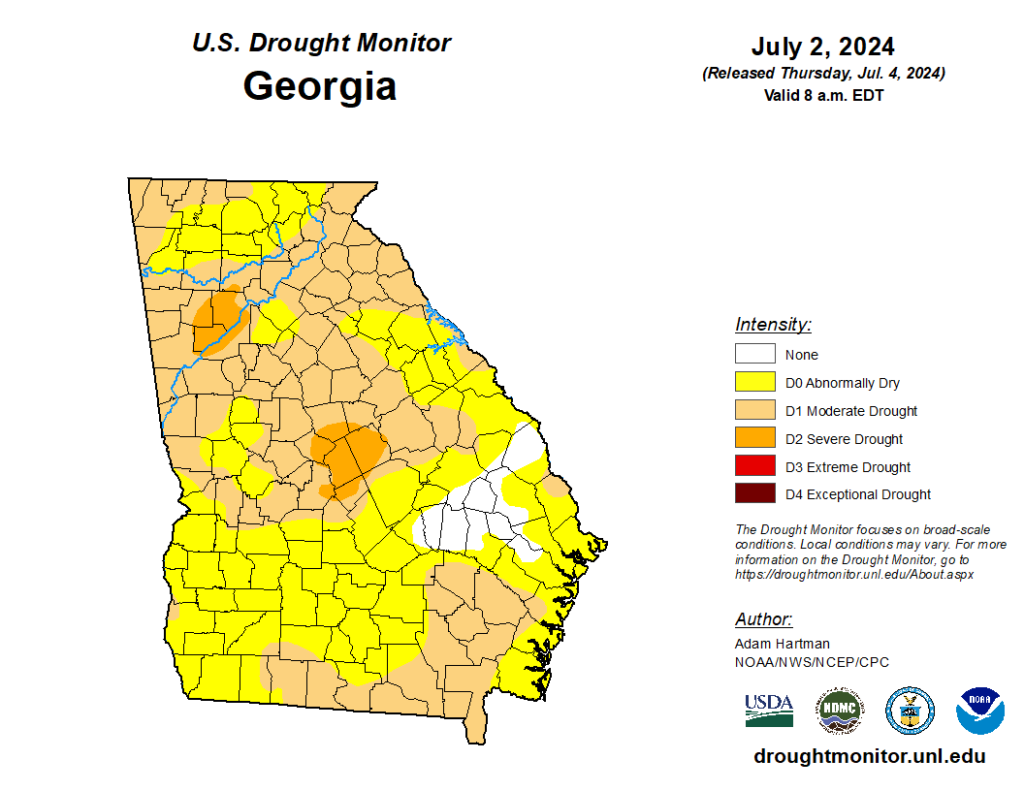Drought. We have heard the word before and we are experiencing it now. Due to this extended period of dryness, the US Drought Monitor has determined that Cobb County is in a Severe Drought.

We have received several phones calls about brown patches, dead grass, fungus, etc. Just know that you are not alone in this endeavor. Many homeowners are seeing their lawns turn from lush areas to burnt crisp. We were fortunate to have a wet spring, which led to an abundance of growth in not only grass, but all plants and trees. The downside of this, is the drought we are currently in mixed wit the UV intensity. There is a way to help supplement your lawns needs during this time.
Proper irrigation is the key to maintaining lawns. This does not mean that you have to install an irrigation system, rather learn the correct way to water your lawn. Depending on the turf variety you have, you soil condition, and the level of drought we are in, the water use varies. Most turf grass owners in Georgia have a clay soil and will need one inch of water per week during the summer months to maintain a green and growing lawn. If you have a bermudagrass, they develop a deeper root system that helps them resist the drought better and access water stored in the soil. Meaning, they are more suited for the climate we are in and have a better chance of staying green during the drought. If you have a variety of Zoysia, they tend to have a shallow root system and need more water due to their inability to access water stored within the soil.
Table 1. provides summer water use rates/drought resistance rankings and irrigation frequency for turfgrass species in Georgia. The water use rate and drought resistance ranking is based on the amount of water used through evapotranspiration and the relative rate the turf begins to show drought stress. The days between irrigations are for mid-summer, high evaporative conditions. The differences between grasses reflect differences in daily evapotranspiration, root depth, viability, and quantity, and turfgrass drought resistance. Under non-irrigated conditions, the relative drought tolerance, or ability to survive without water, becomes more important. Generally, turfgrasses with high water use rates tend to have low drought tolerance.
| Table 1. Summer water use rates/drought resistance rankings and irrigation frequency of turfgrasses used in Georgia. | ||
| COMMON NAME | WATER USE/DROUGHT RESISTANCE | DAYS BETWEEN IRRIGATIONS |
| Bermudagrass | 1 | 14 – 21 |
| St. Augustinegrass | 2 | 12 – 18 |
| Centipedegrass | 3 | 8 – 12 |
| Tall Fescue | 4 | 6-8 |
| Zoysiagrass | 5 | 5-7 |
Mowing during these stress periods should be very cut and dry. Raise your mow height and only move often enough so that no more than 1/3 of the lead tissue is removed during one cutting period. This will help the grass maintain a deeper root system, which helps increase its chances of finding water.
Water is the key to most of your turf needs during this time, but you can water incorrectly. The correct application of water is to only water your turf in the morning hours. If you begin to water in the evening, you are loosing your water to evaporation and can introduce a host of problems.
For a quick recap of anything mentioned above, check out the Cobb County 11 Alive segment that ANR Agent Robert Trawick did on Drought on July 5th, 2024:
If you have any concerns about your grass, or other horticultural and agricultural needs, please call Cobb Extension at 770-528-4070 or email pictures and questions to CobbExtensionANR@uga.edu